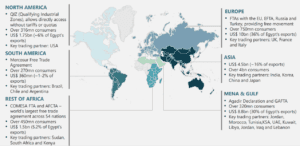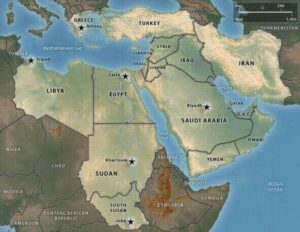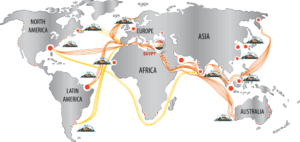The Strategic Importance of Egypt’s Trade Routes
Egypt’s trade routes consist of various air, maritime, rail, and land pathways used to move goods within Egypt and between Egypt and its trading partners. Thus, these trade routes are crucial to Egypt’s trade ties with key markets across fellow African countries, Asia, Europe, the Americas, and the Middle East.
Located in North Africa and the Middle East, Egypt is the:
- 2nd largest economy in Africa
- 42nd largest economy worldwide
Key exports include crude oil / refined petroleum, electrical machinery, fertilizers, iron & steel, plastics, fruits, etc.
Furthermore, its top trading partners include Türkiye, Italy, Saudi Arabia, the UAE, the United States, Libya, Spain, Greece, India, and the UK.

Egypt’s Strategic Importance
- Location: Egypt borders Israel, Libya, and Sudan by land and Cyprus, Greece, Jordan, Saudi Arabia, and Türkiye by sea.
- Suez Canal: Egypt controls the Suez Canal, a vital global shipping route connecting the Mediterranean and Red Seas. It facilitates about 12% of global trade and is crucial for maritime shipments between the Middle East, Europe, and Asia.
- Crossroads of Continents: Egypt sits at the intersection of North Africa, Asia, and Southern Europe. Thus, it makes Egypt a hub for trade and geopolitics.
- Proximity to Conflict Zones: Egypt borders Libya, Sudan, and Israel-Palestine, positioning it as a central actor in Arab, African, and global security matters.
- Regional Power: Egypt’s size, population, and military strength make it a significant regional power.
- Strong Military Presence: The Egyptian Armed Forces are one of the largest in the region, making Egypt a key security partner for the US, Europe, and Arab Gulf states.
- Strategic Alliances: the US, the European Union, China, Saudi Arabia, and the UAE.

Key Egypt’s Trade Routes
Egypt has several key trade routes that facilitate its global imports and exports. These routes are:
- The Suez Canal: A vital maritime trade route for Egypt. It links the Mediterranean Sea to the Red Sea, facilitating global trade between Europe and Asia.
- The Nile River: An ancient inland trade route enabling commerce between Egyptian cities and neighbouring African countries.
- Red Sea Routes: Connect Egypt to the Arabian Peninsula, South Asia, and East Africa.
- Mediterranean Sea: Connects Egypt to European countries.
Egypt’s Maritime Trade Routes
Egypt’s maritime trade routes refer to the sea lanes, ports, and shipping routes crucial for trade with Asia, the Middle East, Europe, and the Americas.
Key Ports in Egypt
Egyptian ports facilitate trade with Asia, Africa, the Americas, and the Middle East, connecting with global shipping routes. These ports include:
Mediterranean Sea Ports (North Egypt)
- Alexandria Port: Located on the Mediterranean Sea, Alexandria is Egypt’s largest and busiest port, handling a significant portion (60%) of the country’s foreign trade. Handles container traffic, general cargo, petroleum products, chemicals and grain. It is a key hub for trade between Egypt and Europe, Africa, the Americas, and the Middle East.
- Port Said Port: Located at the northern entrance of the Suez Canal, Port Said is a key port for container traffic and transhipment. Handles containers, transhipment cargo, and general goods. A key for Egypt’s trade with Asia, Africa, and Europe.
- East Port Said Port: Located along the Eastern side of Port Said, the Mediterranean Sea. Specializes in containerized cargo and transhipment. Part of Egypt’s Suez Canal Economic Zone. Key hub for Asia-Europe container trade.
- Damietta Port: Located 70km west of Port Said, the port specializes in bulk cargo, general cargo, and LNG exports. It is the key export hub for Egyptian LNG and agricultural goods exports to Asia and Europe.
Red Sea Ports (East & South Egypt)
- Ain Sokhna Port: Based near Suez, at the southern entrance of the Suez Canal, it handles containers, petroleum, gas, and industrial goods. Part of the Suez Canal Economic Zone. Also, it manages key energy shipments (LNG, oil, and gas).
- Port of Suez: A key port at the southern entrance of the Suez Canal that handles containers, oil products, and bulk cargo. Serves as a gateway between Europe, Asia, and Africa
- Safaga Port: Located on the Red Sea coast, Safaga Port serves as a primary gateway for trade with the Middle East, Asia, and East Africa. Handles phosphate exports, passenger ferries, cruise ships, and general cargo. It is a key port for trade with the Middle East and East Africa.
- Nuweiba Port: Situated on the Eastern Sinai Peninsula, near the Jordanian border (Gulf of Aqaba), Nuweiba Port serves as a ferry terminal and facilitates trade with Jordan and other countries in the region. Thus, the Key connection point between Egypt and Jordan. Handles passenger ferries, Ro-Ro cargo, and general goods.
Egypt’s Maritime Routes and Trading Regions
- The Suez Canal: Connects the Mediterranean Sea (Europe) to the Red Sea (Asia), facilitating global trade between Europe and Asia. It is the shortest maritime route between Europe and Asia, eliminating the need to cross Africa via the Cape of Good Hope. Thus, it is one of the world’s busiest maritime corridors. Handles about 12% of global trade and 30% of global container traffic.
- Red Sea Trade Route (Egypt-Gulf-Africa): Connects Egypt to trade partners in the Arabian Peninsula, East Africa, and South Asia. Thus, Egyptian goods travel through the Red Sea to reach Saudi Arabia, the UAE, Sudan, Ethiopia, and India.
- Mediterranean Trade Route (Egypt-Europe): This trade route connects Egypt with European countries (Italy, Spain, France, Greece, and Türkiye).

Types of Goods Exported via Maritime Routes
- Petroleum & Petrochemical Products: Crude oil, refined petroleum, Liquefied natural gas (LNG) Petrochemicals (fertilizers).
- Agricultural Products: Citrus fruits (oranges, lemons, mandarins), fresh vegetables (potatoes, onions, garlic).
- Manufactured Goods: Textiles, ceramics, pharmaceuticals.
- Building Materials: Cement, Steel & iron, and marble & granite.
Egypt’s Air Cargo Routes
Egypt’s Air Cargo Routes refer to the network of air freight connections that facilitate the transportation of goods to and from Egypt via air. These routes link Egypt with global hubs in Europe, the Middle East, Africa, Asia, and the Americas.
Key Air Routes & Destinations
Egypt’s air cargo routes connect to a wide range of destinations in:
- Africa: Major cities across North, West, East, and Southern Africa. These include Accra (Ghana), Lagos (Nigeria), Johannesburg (South Africa)
- Europe: Key hubs in Western and Eastern Europe. These include Brussels (Belgium), Frankfurt (Germany), Milan (Italy)
- Asia: Important centres in the Middle East, South Asia, and East Asia. These include Amman (Jordan), Kuwait City (Kuwait), Riyadh (Saudi Arabia)
- North America: Major cities in the United States, such as New York City.
Key Airports in Egypt’s Air Cargo Trade Routes
Egypt’s strategic location as a bridge between Africa, Asia, and Europe has led to the development of several key airports equipped to handle cargo operations.
Here’s an overview of the primary cargo airports in Egypt:
- Cairo International Airport (CAI): Located 15 kilometres northeast of Cairo’s city centre, it is Egypt’s largest and busiest airport. Thus, it is the primary hub for Egypt Air Cargo and other international cargo airlines. Equipped with large cargo terminals and cold storage facilities to handle most air cargo volume to and from Egypt.
- Borg El Arab International Airport: Located about 40 kilometres southwest of Alexandria, this airport is another important hub for air cargo in Egypt. It has modern facilities to support cargo operations destined for or originating from the Mediterranean region.
- Luxor International Airport: Situated in Luxor, serving the southern region of Egypt, LXR accommodates cargo flights, especially those related to perishable goods and artefacts.
- Sphinx International Airport (SPX): Located near Giza, roughly 45 kilometres from Cairo. It supports air cargo operations, including e-commerce and express shipments, especially for the western parts of Cairo and Giza.
- Others:
- Hurghada International Airport: Handles seafood and agricultural exports from Egypt’s Red Sea region.
- Sharm El-Sheikh International Airport: Supports cargo operations mainly for tourism-related goods and perishables.
These airports are crucial in facilitating trade and commerce in Egypt, connecting the country to various destinations worldwide.



